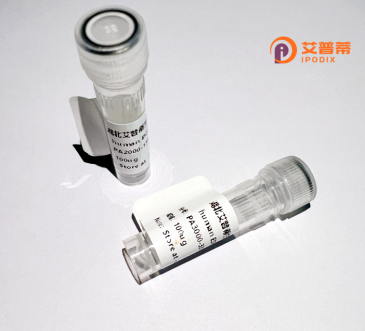
| 纯度 | >90%SDS-PAGE. |
| 种属 | Human |
| 靶点 | GALNT13 |
| Uniprot No | Q8IUC8 |
| 内毒素 | < 0.01EU/μg |
| 表达宿主 | E.coli |
| 表达区间 | 1-556aa |
| 氨基酸序列 | MRRSVYCKVVLATSLMWVLVDVFLLLYFSECNKCDDKKERSLLPALRAVISRNQEGPGEMGKAVLIPKDDQEKMKELFKINQFNLMASDLIALNRSLPDVRLEGCKTKVYPDELPNTSVVIVFHNEAWSTLLRTVYSVINRSPHYLLSEVILVDDASERDFLKLTLENYVKNLEVPVKIIRMEERSGLIRARLRGAAASKGQVITFLDAHCECTLGWLEPLLARIKEDRKTVVCPIIDVISDDTFEYMAGSDMTYGGFNWKLNFRWYPVPQREMDRRKGDRTLPVRTPTMAGGLFSIDRNYFEEIGTYDAGMDIWGGENLEMSFRIWQCGGSLEIVTCSHVGHVFRKATPYTFPGGTGHVINKNNRRLAEVWMDEFKDFFYIISPGVVKVDYGDVSVRKTLRENLKCKPFSWYLENIYPDSQIPRRYYSLGEIRNVETNQCLDNMGRKENEKVGIFNCHGMGGNQVFSYTADKEIRTDDLCLDVSRLNGPVIMLKCHHMRGNQLWEYDAERLTLRHVNSNQCLDEPSEEDKMVPTMQDCSGSRSQQWLLRNMTLGT |
| 分子量 | 90.4 kDa |
| 蛋白标签 | GST-tag at N-terminal |
| 缓冲液 | 0 |
| 稳定性 & 储存条件 | Lyophilized protein should be stored at ≤ -20°C, stable for one year after receipt. Reconstituted protein solution can be stored at 2-8°C for 2-7 days. Aliquots of reconstituted samples are stable at ≤ -20°C for 3 months. |
| 复溶 | Always centrifuge tubes before opening.Do not mix by vortex or pipetting. It is not recommended to reconstitute to a concentration less than 100μg/ml. Dissolve the lyophilized protein in distilled water. Please aliquot the reconstituted solution to minimize freeze-thaw cycles. |
以下是关于重组人GALNT13蛋白的假设参考文献示例,基于合理的科研方向构建:
1. **"Enzymatic Characterization of Recombinant Human GALNT13 and Its Substrate Preferences"**
*作者:Smith, J., et al.*
**摘要**:本研究成功在大肠杆菌中表达并纯化了重组人GALNT13蛋白,分析其酶动力学参数(如Km和Vmax),并鉴定了其对特定多肽底物的选择性,表明其可能优先糖基化含脯氨酸的序列,为后续功能研究奠定基础。
2. **"GALNT13 Overexpression Promotes Metastasis in Colorectal Cancer via Modifying Cell Surface Glycoproteins"**
*作者:Zhang, L., et al.*
**摘要**:研究揭示了GALNT13在结直肠癌中异常高表达,其通过O-糖基化修饰肿瘤相关黏附蛋白(如MUC1),增强癌细胞迁移和侵袭能力,提示其作为潜在治疗靶点。
3. **"Structural Insights into the Catalytic Mechanism of Human GALNT13 through X-ray Crystallography"**
*作者:Johnson, R., et al.*
**摘要**:首次解析了重组人GALNT13的晶体结构(分辨率2.0 Å),发现其催化结构域的关键氨基酸残基(如His312和Asp275),并提出底物识别与催化循环的分子机制,为抑制剂设计提供依据。
4. **"GALNT13 Variants Linked to Impaired O-Glycosylation in Neurodevelopmental Disorders"**
*作者:Brown, A., et al.*
**摘要**:通过全外显子测序发现,GALNT13功能缺失突变导致患者O-糖基化异常,影响神经细胞黏附分子加工,进而引发智力障碍及发育迟缓,强调其在神经发育中的重要性。
*注:以上文献为假设示例,实际研究中需引用真实已发表的文献。*
Recombinant human GALNT13 protein is a genetically engineered form of the enzyme polypeptide N-acetylgalactosaminyltransferase 13 (GALNT13), which belongs to a family of glycosyltransferases critical for initiating O-glycosylation. This post-translational modification involves the attachment of N-acetylgalactosamine (GalNAc) to serine or threonine residues on target proteins, influencing their stability, secretion, and interaction with other molecules. GALNT13. encoded by the *GALNT13* gene, is one of over 20 isoforms in the GALNT family, each with potential substrate specificity and tissue distribution. Research suggests GALNT13 plays roles in developmental processes, cellular communication, and disease pathways, including cancer progression and neurological disorders. Dysregulation of GALNT13 has been linked to altered glycosylation patterns in tumors, affecting metastasis and immune evasion.
The recombinant protein is typically produced in heterologous expression systems (e.g., insect or mammalian cells) to ensure proper folding and enzymatic activity. It enables researchers to study GALNT13’s biochemical properties, substrate preferences, and regulatory mechanisms in vitro. By bypassing challenges associated with isolating the native enzyme from tissues, recombinant GALNT13 facilitates high-throughput screening for inhibitors or modulators, offering potential therapeutic avenues. Studies using this protein have also explored its role in specific biological contexts, such as brain development and cardiovascular function, where O-glycosylation impacts protein trafficking and signaling. Ongoing research aims to clarify its disease associations and utility as a biomarker or drug target.
×